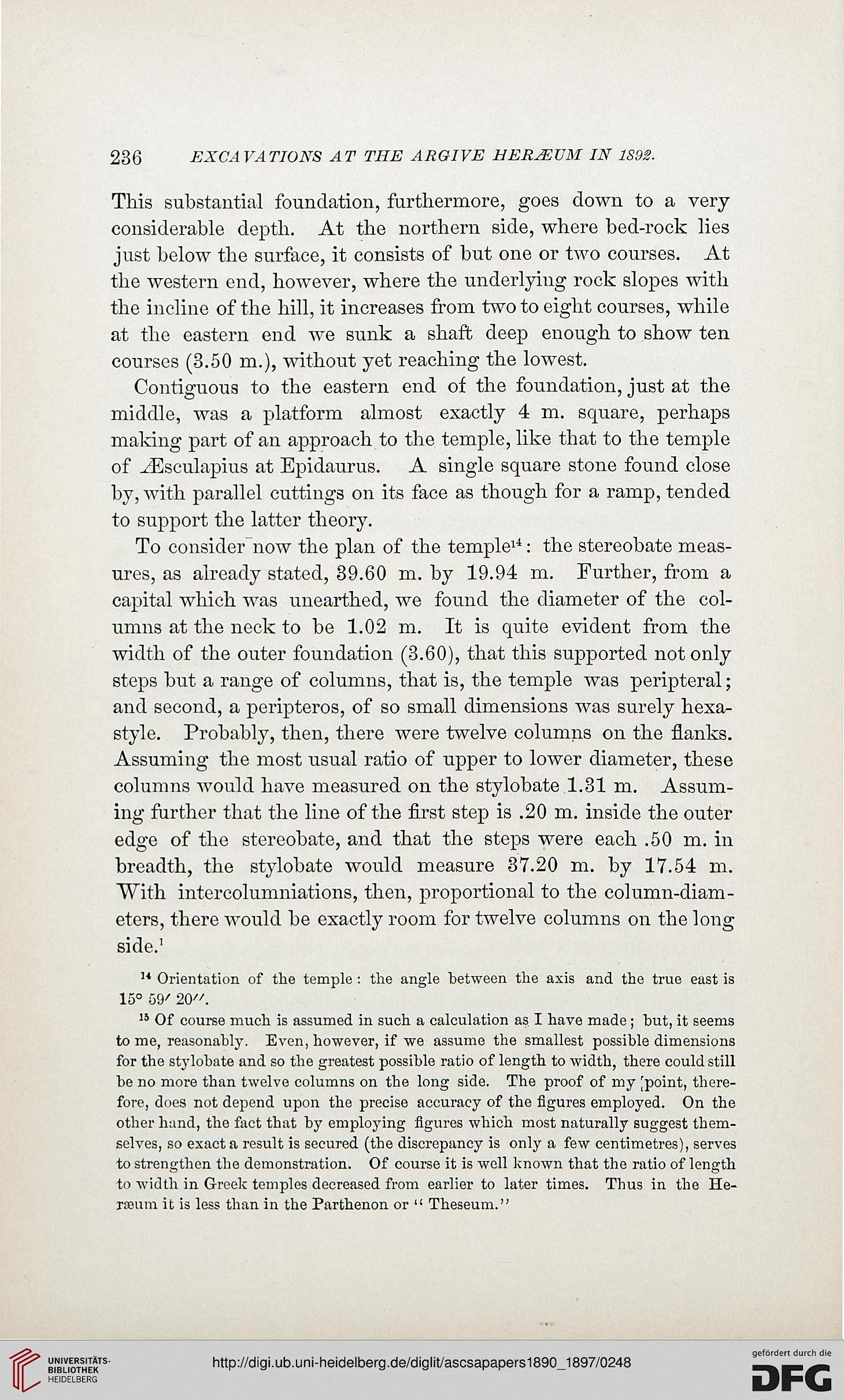236 EXCAVATIONS AT THE ARGIVE HERJEVM IN 1S92.
This substantial foundation, furthermore, goes down to a very
considerable depth. At the northern side, where bed-rock lies
just below the surface, it consists of but one or two courses. At
the western end, however, where the underlying rock slopes with
the incline of the hill, it increases from two to eight courses, while
at the eastern end we sunk a shaft deep enough to show ten
courses (3.50 m.), without yet reaching the lowest.
Contiguous to the eastern end of the foundation, just at the
middle, was a platform almost exactly 4 m. square, perhaps
making part of an approach to the temple, like that to the temple
of yEsculapius at Epidaurus. A single square stone found close
by, with parallel cuttings on its face as though for a ramp, tended
to support the latter theory.
To consider now the plan of the temple11: the stereobate meas-
ures, as already stated, 39.60 m. by 19.94 m. Further, from a
capital which was unearthed, we found the diameter of the col-
umns at the neck to be 1.02 m. It is quite evident from the
width of the outer foundation (3.60), that this supported not only
steps but a range of columns, that is, the temple was peripteral;
and second, a peripteros, of so small dimensions was surely hexa-
style. Probably, then, there were twelve columns on the flanks.
Assuming the most usual ratio of upper to lower diameter, these
columns would have measured on the stylobate 1.31 m. Assum-
ing further that the line of the first step is .20 m. inside the outer
edge of the stereobate, and that the steps were each .50 m. in
breadth, the stylobate would measure 37.20 m. by 17.54 m.
With intercolumniations, then, proportional to the column-diam-
eters, there would be exactly room for twelve columns on the long
side.1
14 Orientation of the temple : the angle between the axis and the true east is
15° 59' 20".
15 Of course much is assumed in such a calculation as I have made ; but, it seems
to me, reasonably. Even, however, if we assume the smallest possible dimensions
for the stylobate and so the greatest possible ratio of length to width, there could still
be no more than twelve columns on the long side. The proof of my [point, there-
fore, does not depend upon the precise accuracy of the figures employed. On the
other hand, the fact that by employing figures which most naturally suggest them-
selves, so exact a result is secured (the discrepancy is only a few centimetres), serves
to strengthen the demonstration. Of course it is well known that the ratio of length
to width in Greek temples decreased from earlier to later times. Thus in the He-
rssum it is less than in the Parthenon or " Theseum."
This substantial foundation, furthermore, goes down to a very
considerable depth. At the northern side, where bed-rock lies
just below the surface, it consists of but one or two courses. At
the western end, however, where the underlying rock slopes with
the incline of the hill, it increases from two to eight courses, while
at the eastern end we sunk a shaft deep enough to show ten
courses (3.50 m.), without yet reaching the lowest.
Contiguous to the eastern end of the foundation, just at the
middle, was a platform almost exactly 4 m. square, perhaps
making part of an approach to the temple, like that to the temple
of yEsculapius at Epidaurus. A single square stone found close
by, with parallel cuttings on its face as though for a ramp, tended
to support the latter theory.
To consider now the plan of the temple11: the stereobate meas-
ures, as already stated, 39.60 m. by 19.94 m. Further, from a
capital which was unearthed, we found the diameter of the col-
umns at the neck to be 1.02 m. It is quite evident from the
width of the outer foundation (3.60), that this supported not only
steps but a range of columns, that is, the temple was peripteral;
and second, a peripteros, of so small dimensions was surely hexa-
style. Probably, then, there were twelve columns on the flanks.
Assuming the most usual ratio of upper to lower diameter, these
columns would have measured on the stylobate 1.31 m. Assum-
ing further that the line of the first step is .20 m. inside the outer
edge of the stereobate, and that the steps were each .50 m. in
breadth, the stylobate would measure 37.20 m. by 17.54 m.
With intercolumniations, then, proportional to the column-diam-
eters, there would be exactly room for twelve columns on the long
side.1
14 Orientation of the temple : the angle between the axis and the true east is
15° 59' 20".
15 Of course much is assumed in such a calculation as I have made ; but, it seems
to me, reasonably. Even, however, if we assume the smallest possible dimensions
for the stylobate and so the greatest possible ratio of length to width, there could still
be no more than twelve columns on the long side. The proof of my [point, there-
fore, does not depend upon the precise accuracy of the figures employed. On the
other hand, the fact that by employing figures which most naturally suggest them-
selves, so exact a result is secured (the discrepancy is only a few centimetres), serves
to strengthen the demonstration. Of course it is well known that the ratio of length
to width in Greek temples decreased from earlier to later times. Thus in the He-
rssum it is less than in the Parthenon or " Theseum."





